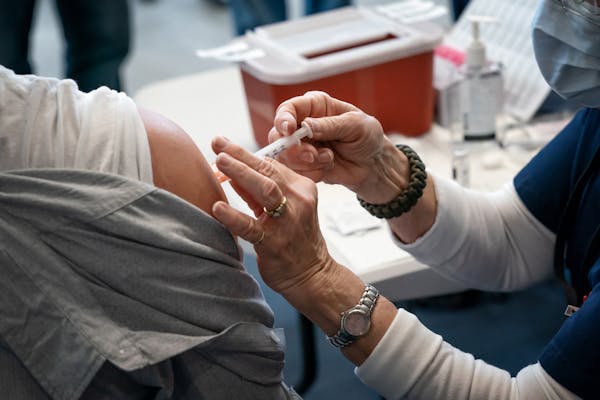Minnesota hospitals are caring for nearly twice as many COVID-19 patients as they did at the end of February following an increase in new coronavirus infections.
As of Sunday, 448 people were in Minnesota's hospitals with COVID-19 complications, compared with 232 on Feb. 28, according to data released by state health officials.
While still below the crisis levels of last fall, hospitals this time around are mostly treating COVID-19 patients who are younger than 65 now that 82.5% of the state's elderly have been vaccinated.
Some evidence suggests that highly infectious and possibly more serious COVID-19 variants are also responsible, sickening those at younger ages who would have otherwise not needed medical care.
In November, 68 of 127 Minnesota hospitals had at least one COVID-19 patient. That number is down to 23 as of last week but still slightly higher than the 19 hospitals with coronavirus patients in mid-February.
"It's been a gradual steady increase," said Dr. George Morris, physician incident commander for COVID-19 response at CentraCare.
"It's been a hard thing seeing ourselves go from single digits where our low was at five [COVID-19 patients] and now we are above 40," he said.
Allina Health hospitals are caring for 140 to 160 COVID-19 patients each day, according to Dr. Ryan Else, vice president of medical affairs at Allina's Mercy Hospital.
"We are seeing fewer admissions of the elderly and our ICU numbers are lower than they were in the winter," he said. "But we are just starting to see this surge."
Mortality rates are down, and that is partly due to the fact that the elderly, who have been hit the hardest by COVID-19, now have more immunity protection because of vaccinations.
"We do know that younger populations do better with the illness than older populations," Else said.
At CentraCare, 70% of COVID-19 patients are younger than 65.
"That was unheard of when we were at the peak of last fall and winter," Morris said.
Even at younger ages, many patients are still hit with serious complications from the coronavirus.
"It is not that these people are just sitting in the hospital in a bed, they are in the hospital, in the ICU," Morris said. "Ten of them are on ventilators. These are young adults and they are there for a long period of time."
Even after they are discharged from the hospital, some could develop long-term complications as a result of coronavirus infection.
Working with the public health laboratory at the Minnesota Department of Health, about 40% of 55 CentraCare COVID-19 patients were found to have a COVID-19 variant, most of them with the B.1.1.7 strain first discovered in the United Kingdom.
"We know that that variant is more contagious and it is looking like it is more serious and more severe," Morris said. "It is a challenge not to view this as a race against time with the vaccine vs. the virus."
'A ticking clock'
Monoclonal antibody treatment, which involves infusion of synthetic antibodies to stimulate an immune response, has been shown to be effective in preventing hospitalizations. But it must be administered soon after COVID-19 infection to have a significant impact.
"There's a ticking clock," Morris said. "We need to get them identified early enough and get them treated during a window of opportunity for them to avoid going into the hospital."
Recent COVID-19 hospitalization numbers could be slightly inflated.
"We are also starting to see COVID-positive patients in the hospital who test positive for COVID but are in the hospital for other reasons," said Dr. Robert Cima of the Mayo Clinic in Rochester.
The hospital is required to include them as COVID-19 patients, even if they are asymptomatic, in reports sent to federal and state officials. Although hospital staff take precautions, those patients are typically not housed on COVID-19 units, Cima said.
During the fall surge, many hospitals scrambled to staff beds because workers were falling ill or they needed to quarantine because they had been exposed to someone who was infected. Vaccination of the health care workforce, which was one of the highest priorities in the state's vaccine rollout, has led to a big drop in staff cases.
"Our staff absences directly related to being COVID positive are dramatically reduced. ... It is very, very low," Cima said.
The guidelines on the length of quarantines have also been shortened from the two-week recommendation that was in place last fall.
"We can get them back into the practice without any risk to patients and staff in a relatively short order," he said.
Rate per 100,000 is up
COVID-19 cases in Minnesota are growing at a rate of 25.6% per 100,000 population, according to the Health Department, compared with a 13.5% growth rate at the end of February.
On Monday, health officials reported 1,385 new COVID-19 cases and 10 additional deaths, including seven who were long-term care residents.
Since the pandemic began, 527,650 state residents have tested positive for COVID-19 and 6,885 have died from complications of the coronavirus.
A total of 1,808,949 state residents have received at least one COVID-19 vaccine dose. That is about 40% of the state population older than 15. Of those, 1,164,182 have received all the recommended doses.

Florian Chmielewski, former senator and Funtime Band accordion player, dies at 97

Minnesota agencies too lax on grant safeguards, legislative auditor finds

Sexually transmitted diseases in Minnesota are down, but HIV and newborn syphilis cases are up

Former MnDOT official approved as Minneapolis public works director

